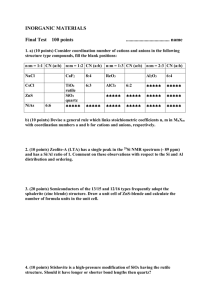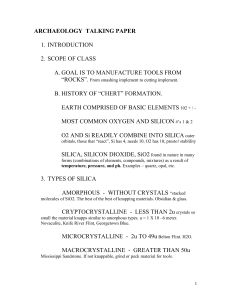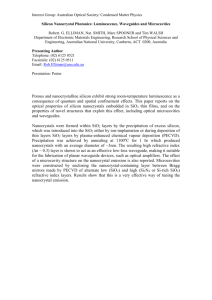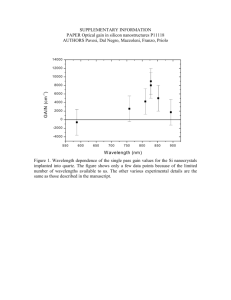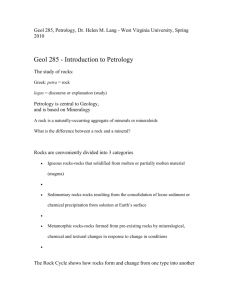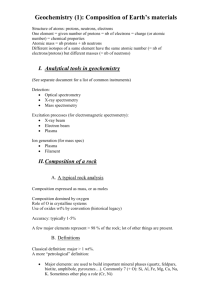Si – Silicon
advertisement
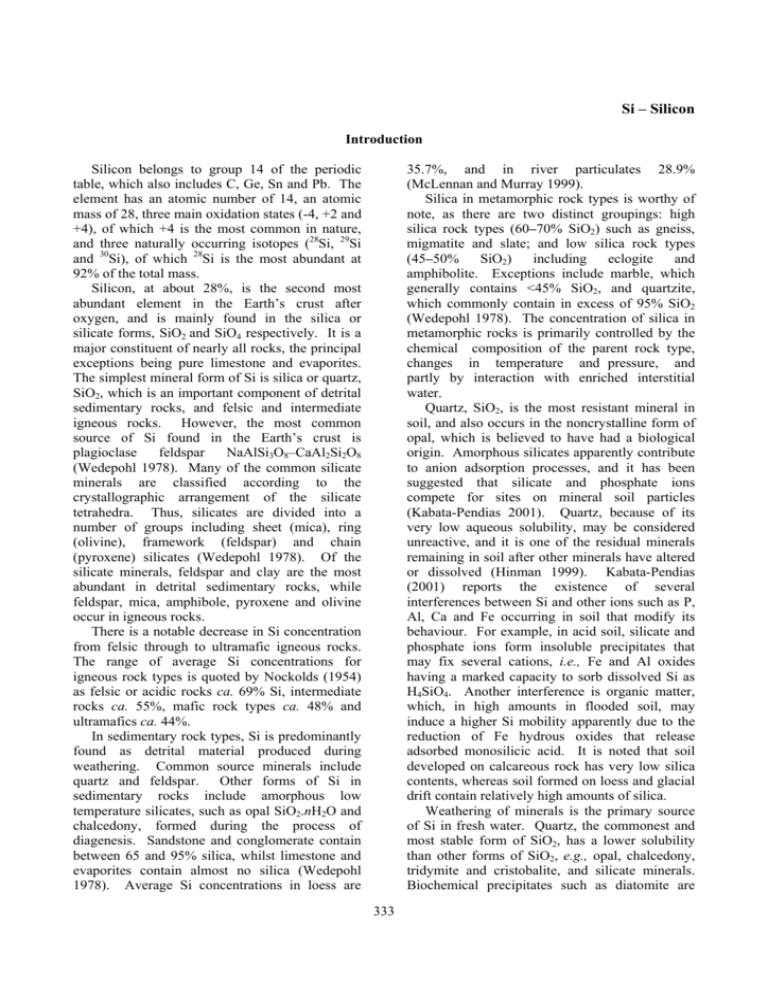
Si – Silicon Introduction 35.7%, and in river particulates 28.9% (McLennan and Murray 1999). Silica in metamorphic rock types is worthy of note, as there are two distinct groupings: high silica rock types (60–70% SiO2) such as gneiss, migmatite and slate; and low silica rock types (45–50% SiO2) including eclogite and amphibolite. Exceptions include marble, which generally contains <45% SiO2, and quartzite, which commonly contain in excess of 95% SiO2 (Wedepohl 1978). The concentration of silica in metamorphic rocks is primarily controlled by the chemical composition of the parent rock type, changes in temperature and pressure, and partly by interaction with enriched interstitial water. Quartz, SiO2, is the most resistant mineral in soil, and also occurs in the noncrystalline form of opal, which is believed to have had a biological origin. Amorphous silicates apparently contribute to anion adsorption processes, and it has been suggested that silicate and phosphate ions compete for sites on mineral soil particles (Kabata-Pendias 2001). Quartz, because of its very low aqueous solubility, may be considered unreactive, and it is one of the residual minerals remaining in soil after other minerals have altered or dissolved (Hinman 1999). Kabata-Pendias (2001) reports the existence of several interferences between Si and other ions such as P, Al, Ca and Fe occurring in soil that modify its behaviour. For example, in acid soil, silicate and phosphate ions form insoluble precipitates that may fix several cations, i.e., Fe and Al oxides having a marked capacity to sorb dissolved Si as H4SiO4. Another interference is organic matter, which, in high amounts in flooded soil, may induce a higher Si mobility apparently due to the reduction of Fe hydrous oxides that release adsorbed monosilicic acid. It is noted that soil developed on calcareous rock has very low silica contents, whereas soil formed on loess and glacial drift contain relatively high amounts of silica. Weathering of minerals is the primary source of Si in fresh water. Quartz, the commonest and most stable form of SiO2, has a lower solubility than other forms of SiO2, e.g., opal, chalcedony, tridymite and cristobalite, and silicate minerals. Biochemical precipitates such as diatomite are Silicon belongs to group 14 of the periodic table, which also includes C, Ge, Sn and Pb. The element has an atomic number of 14, an atomic mass of 28, three main oxidation states (-4, +2 and +4), of which +4 is the most common in nature, and three naturally occurring isotopes (28Si, 29Si and 30Si), of which 28Si is the most abundant at 92% of the total mass. Silicon, at about 28%, is the second most abundant element in the Earth’s crust after oxygen, and is mainly found in the silica or silicate forms, SiO2 and SiO4 respectively. It is a major constituent of nearly all rocks, the principal exceptions being pure limestone and evaporites. The simplest mineral form of Si is silica or quartz, SiO2, which is an important component of detrital sedimentary rocks, and felsic and intermediate igneous rocks. However, the most common source of Si found in the Earth’s crust is plagioclase feldspar NaAlSi3O8–CaAl2Si2O8 (Wedepohl 1978). Many of the common silicate minerals are classified according to the crystallographic arrangement of the silicate tetrahedra. Thus, silicates are divided into a number of groups including sheet (mica), ring (olivine), framework (feldspar) and chain (pyroxene) silicates (Wedepohl 1978). Of the silicate minerals, feldspar and clay are the most abundant in detrital sedimentary rocks, while feldspar, mica, amphibole, pyroxene and olivine occur in igneous rocks. There is a notable decrease in Si concentration from felsic through to ultramafic igneous rocks. The range of average Si concentrations for igneous rock types is quoted by Nockolds (1954) as felsic or acidic rocks ca. 69% Si, intermediate rocks ca. 55%, mafic rock types ca. 48% and ultramafics ca. 44%. In sedimentary rock types, Si is predominantly found as detrital material produced during weathering. Common source minerals include quartz and feldspar. Other forms of Si in sedimentary rocks include amorphous low temperature silicates, such as opal SiO2.nH2O and chalcedony, formed during the process of diagenesis. Sandstone and conglomerate contain between 65 and 95% silica, whilst limestone and evaporites contain almost no silica (Wedepohl 1978). Average Si concentrations in loess are 333 Concentrations of Si in fresh water range typically from 1 to 30 mg l-1, i.e., less than the solubility of amorphous silica (58 mg l-1). Concentrations of up to 100 mg l-1 have, however, been measured in some groundwater (Hem 1992). Silicon is one of humankind’s most utilitarian elements. In the form of sand and clay it is used to make concrete and brick, is one of the principal components of glass, is a useful refractory material and, in the form of silicate minerals, is used in making enamels, pottery, etc. Elemental silicon and its intermetallic compounds are used in a wide range of alloys, in the manufacture of organosilicic and silicon resins, seals and oils, and in the production of silicon chips. Input of Si to the environment from anthropogenic and other sources is, however, minimal given its geogenic abundance (Aston 1983). Silicon is essential for the development of vertebrates. A deficiency in the diet can result in bone and cartilage problems (Carlisle 1972, Schwarz and Milne 1972). Despite considerable research, the reason why Si is essential is not known, since no biological molecules have been found which contain or require Si. It may be that its main role is to exclude potentially toxic Al from the body, or to reduce the toxicity of Al once it has entered the body via the formation of an aluminosilicate similar to imogolite (Exley 1998). In general, Si is considered to be inert and essentially non-toxic. However, occupational exposure to crystalline silica, specifically quartz and cristobalite, can (as a consequence of the grain size of the mineral) result in bronchitis, emphysema, immunologic disorders and lung cancer. Table 60 compares the median concentrations of Si in the FOREGS samples and in some reference datasets. more readily weathered than quartz and silicate minerals; seasonal differences in Si concentrations in fresh water are also influenced by Si uptake by diatomite, which is more significant during the summer. The influence of bedrock composition and soil physico-chemical conditions on the Si content of stream water depends on the relative contribution of groundwater and the nature of the hydrological response of the catchment to storm events. The modifying effects of rain dilution and hydrological pathways are important, as soil water is more variable in Si content than stream water. Silicon released by weathering enters solution as silicic acid, H4SiO4 or Si(OH)4, a weak acid that remains undissociated below pH 9 (Iler 1979, Krauskopf 1982). Where Si is present at high concentrations, i.e., >58 mg l-1, Si may exist as colloidal amorphous SiO2 or polymeric Si. Phytolith Si released during plant decay is also typically colloidal. Although Si may be thermodynamically unstable in solution above a level defined by solubility equilibria, higher concentrations may occur where kinetic constraints preclude precipitation. Hem (1992) proposes that, in some natural water, an amorphous clay-mineral weathering product of the composition of halloysite Al4Si4O10(OH)8.8H2O may constrain the concentration of Si, and also Al, above the solubility of quartz. High activities of H4SiO4 in water give rise to the formation of semi-colloidal Si-Al complexes. Adsorption and desorption processes on the surfaces of Fe and Al oxyhydroxides, e.g., ferrihydrite and goethite, also act as a buffer in river systems (Aston 1983). Natural organic materials do not appear to complex Si, but colloidal Si and clay particles may become entrained in their matrices if, for example, there is a substantial change in pH. SiO2 (silica) in soil be expected in such a large survey. When the proportion of quartz grains in a soil sample is higher, its proportion of fine-grained clay and silt is lower. This phenomenon influences the variation of most elements to some degree, as quartz (the major carrier of SiO2) tends to dilute the other constituents in the sample. As observed on the SiO2 distribution maps, there is an obvious influence of the geological substrate at the regional and continental scale, suggesting that The median SiO2 content in subsoil is 68.0% and in topsoil 67.7%, and he range of values varies from 0.61 to 98.1% in subsoil and 1.47 to 96.7% in topsoil. These are widely contrasting values, which are due to lithology and to the prevailing pedogenetic processes in the widely differing European morphoclimatic environments. The average ratio topsoil/subsoil is 1.017. There is a good correlation between grain size and silica content in soil samples, and this should 334 Table 60. Median concentrations of SiO2 in the FOREGS samples and in some reference data sets. Silica (SiO2) Crust1) Origin – Source Number of samples n.a. Size fraction mm n.a. Extraction Total Median % 66.6 Subsoil FOREGS 788 <2.0 Total (XRF) 68.0 Topsoil FOREGS 845 <2.0 Total (XRF) 67.7 World n.a. n.a. Total 59.8 Water FOREGS 808 Water3) World n.a. Filtered <0.45 µm n.a. Stream sediment FOREGS 850 <0.15 Total (XRF) 61.3 Floodplain sediment FOREGS 749 <2.0 Total (XRF) 64.6 Soil 2) Upper continental 8.03 (mg l-1) 6. 0 (mg l-1) 1) Rudnick & Gao 2004, 2)Koljonen 1992, 3)Ivanov 1996. grain-size distribution in soils is determined in a large part by the local geology. Apart from grain size of soil, a second factor influencing SiO2 distribution is, of course, bedrock geology: calcareous areas contain a smaller amount of SiO2. The distribution maps for both subsoil and topsoil demonstrate that the calcareous areas in southern Europe have the lowest SiO2 values (<58.1%). This is the case in the eastern half of Spain, southern and eastern France, coastal Croatia, the Alps, and the western Carpathians of Slovakia. Most of Italy and parts of Greece have low SiO2 values, because of low-silica crystalline rocks and limestone. Highest SiO2 values in subsoil (>76.0%) are located mainly in the sandy lowlands of northern continental Europe, i.e., Poland, northern Germany and Denmark, which are mostly covered by Quaternary sediments of glacial and periglacial origin and produce luvisols or loessic soils. Ireland shows mostly high SiO2 values despite its outcropping limestones, which are masked by the glacial till (soils are not residual in the strict sense). To the north (Fennoscandia, Baltic states, Britain), the SiO2 content gradually decreases to the continental average values. To the south (towards central Europe), the decrease is very sharp and marks the limit of the Quaternary glacial extension. Some sandy alluvial plains, especially near the coast, are high in SiO2 as expected, e.g., the rivers Teijo (Portugal), Guadalquivir (Spain), Thames (England), the Rhine basin in Hessen (south-central Germany) and in the Netherlands, and the Danube in central Hungary. In northern France, the SiO2 soil anomalies mark the Tertiary fluviatile palaeochannels (Ypresian), and in south-west France, they correspond to the Tertiary Aquitanian molasse. Negative correlations, to be interpreted as autocorrelations in a closed number system (see introduction), with SiO2 include: (i) Ca (-0.78 in subsoil, -0.72 in topsoil), pH (-0.39 subsoil, -0.35 topsoil) and Sr (-0.38 subsoil, -0.41 topsoil), which are typically high in calcareous rocks, e.g., Greece, western Ireland, Italy, the eastern Paris basin in France, eastern Spain; (ii) Fe (-0.38 in subsoil, -0.50 in topsoil) and Mg (-0.49 in subsoil, -0.57 in topsoil), typical for mafic Si-poor crystalline rocks, e.g., Albania, Greece, Canary Islands, northern Ireland, and south-west-Italy; and (iii) elements such as V (-0.43 in subsoil), and Sc, Al, Ga, Cu, Co, Ni, I, S, In, Te (all between 0.3 and -0.4), which are generally enriched in fine-grained sedimentary rocks and their metamorphic derivatives, and consequently in soils developed over these rocks. A negative correlation with TOC (-0.34 in subsoil) is caused by a restricted number of samples with extremely high organic carbon content, reducing silicates to minor constituents. The pattern of correlation coefficients is the same for subsoils and topsoils. The scattergram SiO2-CaO (Figure 41) shows that for soil overlying low-Ca rocks (silicatetype), the SiO2 content is independent of the CaO content, whereas soils overlying high-Ca rocks (limestone-type) show a pronounced negative trend with SiO2: the more CaO, the less SiO2 is present. The scattergram SiO2-Al2O3 (Figure 42) clearly shows two populations: for SiO2 values above 60% the trend is negative and well335 pronounced, whereas for <60% SiO2 a rather positive, but ill-defined trend, is visible, reflecting a negative correlation for both Al2O3 and SiO2 with CaO in soil on calcareous rocks. Figure 41. Scattergram of SiO2 and CaO concentrations in subsoil. Figure 42. Scattergram of SiO2 and Al2O3 concentrations in subsoil. Silicate in stream water draining Palaeocene silica-rich limestone with opal cement and chalcedony-bearing chert layers. In eastern Poland, the probable reason for the high content in stream water is intensive leaching of sandy soil and geological basement. High SiO2 contents in south-central and south-eastern Slovakia is related to the regional presence of Tertiary volcanic rocks of predominantly andesitic composition. High values in central Spain occur in the crystalline rocks of the Cordillera Central, in southern Spain they are associated with clastic lithologies of the Baetic Cordillera, and in the Alicante region with Permo-Triassic sandstone. The point Si anomaly in the western Bavarian Forest is related to lithological sources. There is no explanation for the high isolated values in the Landes in south-west France, except for the general acidity of this pine forest region. Silica distribution in stream water is pHdependent, and its soluble form is the weak silicic acid. Silica follows the Major-ions type distribution pattern that is influenced by exogenic factors, such as climate, vegetation and topography, and not by geology. An inverse relationship with the elements of the chalcophile base metals waters is observed, among other Silicate values in stream water range over almost three orders of magnitude, from <0.1 to 72 mg l-1, with a median value of 8 mg l-1. Silicate is generally inversely correlated to pH, although there are other controls that dominate in some areas. Lowest silicate values in stream water (<3.5 mg l-1) are found throughout Norway, small parts of southern Finland, western Scotland, western Wales, north-west Ireland, northern Spain and over the central Alps, Slovenia and western Croatia. Enhanced silicate concentrations in stream water (>14 mg l-1) are found within central France, southern and western rim of the Iberian Peninsula, eastern and northern Greece, Sardinia, the Roman and Neapolitan alkaline magmatic provinces of Italy, and in a belt through eastern Germany, western Czech Republic, Hungary and Croatia, and in south-eastern Poland. These values are associated with a range of lithologies. In Italy, the high values are related to alkaline volcanics in the Campania and Latium regions, and in Greece to Tertiary sediments, molasse deposits, gneiss, schist, shale, and felsic intrusives. A point anomaly in central Belgium occurs in a river 336 of Si in stream water is given in Annex 1 of this volume by Ander et al. (2006), where the thematic interpretation of stream water chemistry is discussed (see section on Al and Si speciation and solubility). areas, in eastern Spain, Paris Basin, Germany, Corsica, volcanic areas of central Italy, Greece; this aspect of its behaviour is geogenic. A more detailed description on the chemistry SiO2 (silica) in stream sediment and towards the west by sandy Quaternary and Tertiary basin deposits. In Lithuania, SiO2 values are lower than in neighbouring Poland, Estonia and Latvia due to deliberate sampling of finegrained stream sediment, in a continental region with otherwise similar geological background. To the south of the sandy northern continental plains (towards central Europe), silica content decreases rather sharply, marking the southernmost limit of the Quaternary glacial extent. In south-west France high silica values correspond to the Eocene Aquitanian molasse in the Garonne basin, overlain by aeolian sands. High SiO2 values in south-eastern Norway and most of Finland reflect high SiO2 bedrock; in central Finland, granodiorite is responsible. As the major mineral phases of stream sediment generally are either silicates or carbonates, it is not surprising that a negative correlation of SiO2 (autocorrelation) is observed with Ca (-0.78), but also with MgO (-0.54) and Sr (-0.40). Silica has a good positive correlation with Zr (0.44) and Hf (0.40), pointing to the mineralogical association of zircon with quartz. The median SiO2 content in stream sediments is 61.7%. The range of values varies from 2.5 to 94.0%. These are extremely contrasting values, which are due essentially to the huge contrast in geological background where the stream sediment samples were collected. In southern Europe areas underlain by calcareous rocks show low (<53.5%) SiO2 values in stream sediment. This is the case in the eastern part of Spain, southern and eastern France, large parts of Great Britain, western Ireland, Slovenia, Croatia, the eastern Alps. In Italy and Greece, low SiO2 values are caused in part by limestone and in part by low-silica crystalline rocks. In northern Portugal and northern and central Sweden, crystalline rocks are responsible for low silica values. The distribution map shows that SiO2 in stream sediment is clearly high (>69.8%) in the sandy lowlands of northern continental Europe, i.e., Poland, the Baltic states, northern Germany and Denmark, the Netherlands, Belgium and northern France, which are mostly covered by Quaternary sediments of glacio-fluvial and periglacial origin, SiO2 (silica) in floodplain sediment Austria, south Germany, western Hungary, Slovenia, Croatia, Albania and Greece with a variable lithology, where calcareous rocks are dominant together with mafic and ultramafics. The three lowest SiO2 values are located in the Western calcareous Alps in France (7.9%), in the molasse basin of Austria (9.3%), and in the calcareous Paris basin (10.3%). High Si2O values in floodplain sediment (>72%) occurring in the glacial drift region extending from north Germany to Poland, Lithuania and Latvia; the predominantly granite area of central and southern Sweden; the granitoid and metagreywacke area of south-east Finland; the granite, schist-gneiss, Old Red Sandstone and Millstone Grit terrains of northern England and Total Si2O distribution in floodplain sediment shows a pronounced variability from 7.9 to 100%, with a median of median 64.6%, which is related to the bedrock geology (sandstone, granite, granodiorite and their metamorphosed equivalents), but also to quartz-rich superficial deposits (loess and glaciofluvial deposits). Low SiO2 values (<55.2%) are encountered in floodplain sediment derived from mainly calcareous rocks in north-central France, the alluvial plain of the lower Charente river basin in western France; the calcareous and clastics of most of eastern Spain; a large area with low SiO2 values covering the Alpine Orogenic belt extending from the Western Alps, most of Italy, southern Switzerland and stretching across to 337 Silica in floodplain sediment shows a very strong negative correlation (autocorrelation, see soil) with CaO (-0.81), a good negative correlation with MgO (-0.52) and Sr (-0.51), and a weak negative correlation with S (-0.34); it has a weak positive correlation with Zr (0.39). In conclusion, the distribution of Si2O in floodplain sediment maps areas with felsic crystalline rocks, greywacke, sandstone, and especially the North European Plain with its glacial drift deposits (Salpeteur et al. 2005). Another notable feature are the low SiO2 values in areas dominated by carbonate rocks. Scotland, the Lower Palaeozoic rocks of northeast Ireland; the alluvial deposits of the lower Garonne River basin in France; the large alluvial basins of the Duero in the northern Spanish meseta with sediments derived from the crystalline Iberian Massif and Cantabrian Mountains; the lower Guadalquivir River basin with a load of detritus from the mountain ranges of southern Spain; and the calc-alkaline volcanics of southern Sardinia. Of the four highest anomalous SiO2 values, three are located in the glacial drift area of southern Poland (99.9, 98.1 and 96.1%), and one in the lower Garonne River basin in south-west France (96.1%). SiO2 comparison between sample media Patterns in SiO2 distribution between all solid sample media are very similar, with only a few exceptions. Silica is higher in a region extending from Belgium through to Normandy in stream sediments compared to topsoil and subsoil and, especially, floodplain sediment. In Ireland and throughout parts of Britain, stream sediment data are much lower in SiO2 than in soil, and SiO2 in floodplain sediment is much higher in the northern parts of Britain and northern Ireland compared to all solid sample media. SiO2 is also enriched in floodplain sediment throughout central and northern Spain and southern Sardinia compared to other solid sample media. In Lithuania, stream sediment SiO2 data tend to be lower than in other solid sample media; in Latvia, topsoil and stream sediments SiO2 values are higher than in subsoil and floodplain sediments; in Estonia, stream sediment values are higher than those of floodplain sediment. A boxplot comparing SiO2 variation in subsoil, topsoil, stream sediment and floodplain sediment is presented in Figure 43. Stream water SiO2 data show mainly opposite patterns to those observed in solid sample media. This is particularly marked in parts of eastern Greece, central Italy, southern Spain and Portugal, where stream water SiO2 values are much higher than that in solid sample media, and throughout the whole of Norway, western Sweden, eastern Finland and Ireland, in which stream water data are much lower than in solid sample media. Figure 43. Boxplot comparison of SiO2 variation in subsoil, topsoil, stream sediment and floodplain sediment. 338


